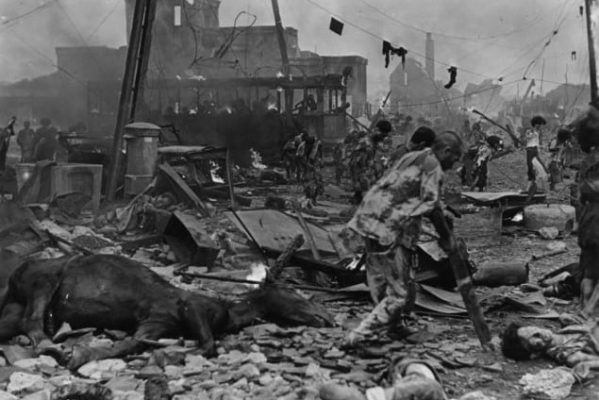Hideo Sekigawa’s Hiroshima has somewhat languished in obscurity for unfathomable reasons. For sure, the 1950s was a decade packed with masterpieces from Japan (Ugetsu, Ikiru, Life of Oharu, Tokyo Story, Seven Samurai etc, etc, etc), but Sekigawa’s sombre, sober examination of the day that effectively ended Japan’s war is by no means a lesser work.
Hiroshima examines the bombing of the city on 6 August 1945 and the immediate aftermath, following the members of the Endo family as they pick their way through the burning wreckage. The depiction of that fateful day is bookended by contemporary scenes of a schoolteacher going over the ‘flash bang’ with his class. Many of the children are survivors of the initial blast but are now being felled by leukaemia, or the ‘A-bomb disease’. The story also catches up with the son of the Endo family seven years on, now grown into a haunted young man.
Filmed in some of the remaining ruins using actual survivors of the atrocity (known as Hibakusha), Hiroshima is a vivid, intense and harrowing experience with a documentary eye for its horrors that puts it in the league of punishing classics like Mick Jackson‘s Threads or Peter Watkins‘ The War Game. Despite decades of accrued desensitisation thanks to instant reportage of every human tragedy, it’s still difficult viewing. The blast itself is shown in silence as a brief series of quick cuts that give way to obliterating white light. It’s a chilling and artful way of showing the instantaneous carnage; a prosperous city one second, a massive charnel house the next. As much horror is evoked by the sound design as the visuals. The sound is a disorientating barrage of screams and wails, punctuated by the cries of babies and embellished by a choral score of aching mournfulness.
The scenes in the present are less instantly horrendous, but still powerful. From a dying schoolgirl listing the symptoms of her leukaemia to her classmates, to the homeless children who have taught themselves the word ‘hun-ga-ri’ to yell at occupying soldiers for morsels of food. Behind the scenes clashes between governmental forces driven by ideology and pragmatic scientists will also likely cause a shiver of recognition given our current situation. There are a few narrative missteps, such as an implication that the bombing itself is going to be recollected by the sick schoolgirl; a small piece of sloppy editing perhaps more than anything else. It also gives way to sentiment in a few places, when its strength is in its otherwise unflinching, realist approach.
The genesis of the film is interesting in itself. It was the second time in the space of a year that the book, Children of the Atomic Bomb was adapted for the screen. The first, as Children of Hiroshima by Kaneto Shindô (a resident of the city for his entire 100 years) angered the studio as it was a straight retelling with no polemical angle. Sekigawa’s version is fuelled both by understandable anti-American rage and a near paranoiac wrestling with Japan’s own intense nationalistic tendencies lest such an apocalypse ever be brought to their shores again. It also features some actors who would go on to be recognisable faces: Eiji Okada who plays the schoolteacher would go on to woo Emmanuelle Riva in Alain Resnais‘ Hiroshima Mon Amour, while Isuzu Yamada would manipulate Toshirô Mifune to murder in Kurosawa’s Throne of Blood.
Japanese cinema would soon find a new, more oblique and palatable way of reckoning with its intense trauma; 1954 saw the release of Ishirô Honda‘s Godzilla. Not only was it a potent metaphor for the nuclear age, its worldwide success could be seen as symbolic of the new global, capitalist force Japan soon became. But on its own terms Hiroshima is still hugely powerful as an attempt to communicate a profoundly unspeakable act. So soon after the event, it’s a surgeon’s finger pressed into a fresh wound, but this ensures its potency remains.
Available on Blu-ray from Mon 13 Jul 2020
